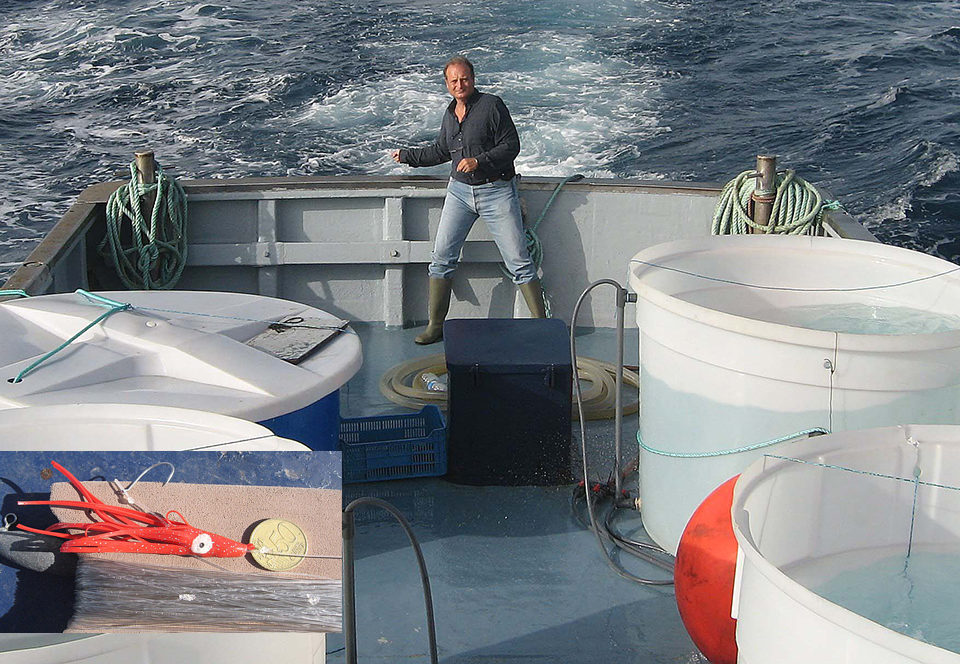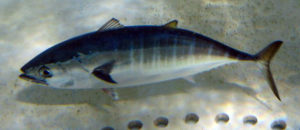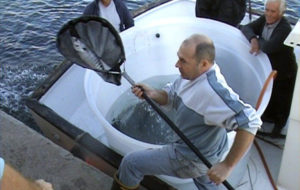Move to manufactured feeds is crucial for development of tuna aquaculture

Developing a self-sustaining aquaculture industry for bluefin tuna requires the availability of high-efficiency feeds with low environmental impact. Once larval rearing of bluefin tuna is accomplished, further experimentation with hatchery-produced juveniles will be possible.
Meanwhile, to work on the nutrition and feeding aspects of bluefin tuna, the authors utilize wild-caught juveniles that are adapted to culture conditions in sea cages, as is also done with fish species like greater amberjack and the freshwater eel.
Concurrently, the transport of juvenile bluefin tuna to land-based facilities for trials in tanks provides the opportunity to study important parameters such as oxygen consumption and feed digestibility. Once the wild-caught juveniles adapt to captivity in sea cages, they can be weaned to artificial diets.
Previous studies

In a November 2006 trial, tuna juveniles were captured in two places on the shore of Murcia in southeastern Spain: 9.6 km from Cabo de Palos Port and throughout Mazarrón Bay. Capture was performed using plastic-baited barbless hooks in order to avoid injuries to the mouths of the fish. Using a fishing method called “curricán” in Spanish, fishing gear was trailed behind a boat at a constant speed of 6 knots.
Captured fish were suspended by the line without touching them, set free from the hooks and placed in 1.45- to 1.65-meter diameter cylindrical plastic tanks with 1.2 cubic meters of seawater for transport to land-based facilities. The water temperature was 19 to 20 degrees-C.
A van with similar plastic tanks was used to transport the fish overland. Equipment to supply pure oxygen and a circular water current was arranged in the tanks under a double bottom with holes to avoid any obstacles to the normal swimming of the tuna.
From a total of 57 captured individuals weighing 1.58 ± 0.19 kg and with a 43.0 ± 1.5 cm fork length, only 12 were transported alive from the fishing areas to the land-based facilities. All individuals that swam regularly in the transport tank on the boat withstood the overland transport and arrived alive at the Spanish Institute of Oceanography facilities. In the institute’s cylindrical 20-cubic-meter fiberglass tank with a 4-meter diameter, the fish swam regularly in circles without touching the tank walls.
However, no fish survived more than 72 hours. The dead fish showed dark areas on their surface and injuries to the skin. Thus, it would be necessary to design a system that minimizes this friction or capture smaller animals.
Secondary study

From September to November 2008, in the framework of the SELF-Sustaining Aquaculture – Domestication of Thunnus thynnus (SELFDOTT)* Project cofunded by the European Commission, the authors captured and transported bluefin tuna juveniles to a floating cage placed in El Gorguel Bay in southwestern Spain.
By 2010, the project proposes to implement the knowledge already obtained on the artificial control of reproduction of bluefin tuna to obtain viable eggs and study embryonic and larval development for the production of fry. At the same time, environmentally responsible grow-out feeds will be developed, thus reducing or eliminating the practice of raw fish importation and feeding by the tuna-fattening industry.
In work headed by the Spanish Institute of Oceanography with the participation of the Spanish company Tuna Graso, the Hellenic Centre for Marine Research, Skretting Aquaculture Research Centre and other regional and international partners, fish were captured with the same curricán method used in the previous trial, but then placed in a circular 25-meter-diameter floating cage with 20-meter depth. Compared to the previous trial, survival after one month in the cage was high (75 percent), while close to 50 percent of the captured fish arrived alive to the cage.
The main mortality in this process owed to difficulties in freeing fish from the hooks, although the hooks were barbless. Usually, if a fish bleeds by the gills, it dies. Besides this, some fish tended to swim touching the tank walls.
Survival is much higher than previously measured because the duration of the transport of the fish in the plastic tank was quite short, and they were handled less. The tuna were moved with a rubber net just once from tank to cage, and they recovered more readily in the huge mass of seawater inside the cage.
Research perspectives
Further trials are planned to transport tuna to tanks at the Spanish Institute of Oceanography facilities. Once in the tanks, the behavior and oxygen consumption of the fish will be monitored. High survival is expected, given that the fish should experience lower stress after adapting to captivity and the human presence in the cages. Bigger tanks – with 6-meter diameter and 2-meter height – will also be used.
Concurrently, bluefin tuna juveniles will be adapted to artificial food, while environmental monitoring of the experimental facilities is carried out. The results will be analyzed in terms of reducing the environmental impacts of feeding based on raw fish. Up to now, the fish have adapted well to very actively consume chopped, defrosted mackerel, and they will likely adapt readily to feed on artificial feeds.
* This study was carried out with financial support from the Commission of the European Communities, specific RTD programme of Framework Programme 7, SELFDOTT. The Community is not liable for any use that may be made of the information contained therein, nor does it necessarily reflect its views and in no way anticipates the Commission’s future policy in this area.
(Editor’s Note: This article was originally published in the March/April 2009 print edition of the Global Aquaculture Advocate.)
Now that you've finished reading the article ...
… we hope you’ll consider supporting our mission to document the evolution of the global aquaculture industry and share our vast network of contributors’ expansive knowledge every week.
By becoming a Global Seafood Alliance member, you’re ensuring that all of the pre-competitive work we do through member benefits, resources and events can continue. Individual membership costs just $50 a year. GSA individual and corporate members receive complimentary access to a series of GOAL virtual events beginning in April. Join now.
Not a GSA member? Join us.
Authors
-
Fernando de la Gándara
Spanish Institute of Oceanography
Planta de Cultivos Marinos
Carretera de la Azohía
s/n 30860-Puerto de Mazarrón
Murcia, Spain[115,101,46,111,101,105,46,117,109,64,111,100,110,97,110,114,101,102]
-
Aurelio Ortega
Spanish Institute of Oceanography
Planta de Cultivos Marinos
Carretera de la Azohía
s/n 30860-Puerto de Mazarrón
Murcia, Spain
Tagged With
Related Posts

Health & Welfare
Achotines laboratory home to continuing studies of tuna early life history
The Inter-American Tropical Tuna Commission Achotines Laboratory in southern Panama is the world’s only facility with nearly year-round availability of tuna eggs and larvae. A study is comparing the reproductive biology, genetics and early life history of yellowfin and Pacific bluefin tuna.

Innovation & Investment
Aquaculture Exchange: Daniel Benetti
University of Miami professor says the U.S. seafood marketplace needs to embrace 'plate-sized' fish if a domestic aquaculture industry is to become sustainable and profitable.

Innovation & Investment
Tuna aquaculture: Fishing for progress
Aquaculture could be a sustainable alternative to fishing for tuna but achieving commercial-scale production has proven challenging.

Innovation & Investment
Japan hopes aquaculture can save bluefin tuna
Bluefin tuna may be the most prized fish in the ocean. If hon-maguro sashimi is to remain chic, closed-cycle aquaculture may help keep it on menus.


